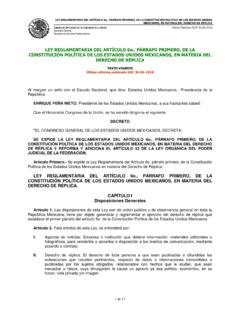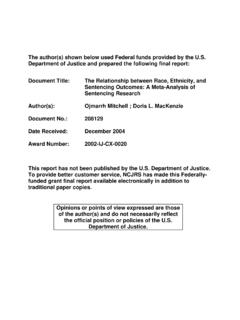Transcription of PLANT PROPAGATION - California Rare Fruit Growers, Inc.
1 PLANT PROPAGATION An Overview of PLANT PROPAGATION Methods Two Techniques of Stem Cutting PROPAGATION Types of PROPAGATION Sexual PROPAGATION : Seed Asexual PROPAGATION : Division & Separation Cuttings Grafting & Budding Layering Tissue Culture Sexual PROPAGATION : Seed The result of combining characteristics from two parents, plants grown from seed are never an identical replica of either parent. plants grown from seed are often highly variable. Although some plants are more reliable from seed and a few plants are true from seed, these are exceptions to the rule. When grown from seed, plants must grow through a juvenile stage and become mature enough to reproduce. This generally takes from 3-15 years for most fruiting plants .
2 Seed PROPAGATION is generally used by PLANT breeders when trying to develop new plants with characteristics different from plants that are already in cultvation. Asexual PROPAGATION : Division PROPAGATION by division is the simplest form of PROPAGATION . plants with more than one rooted crown may be divided and the crowns planted separately. If the stems are not joined, gently pull the plants apart. If the crowns are united by horizontal stems, cut the stems and roots with a sharp knife or pruners to minimize injury to the PLANT . Divisions of some outdoor plants should be dusted with a fungicide before they are replanted. Examples: snake PLANT , iris, prayer PLANT , day lilies. Asexual PROPAGATION Separation Separation is a term applied to a form of PROPAGATION by which plants that produce bulbs or corms multiply.
3 Bulbs New bulbs form beside the originally planted bulb. Separate these bulb clumps every 3 to 5 years for largest blooms and to increase bulb population. Dig up the clump after the leaves have withered. Gently pull the bulbs apart and replant them immediately so their roots can begin to develop. Small, new bulbs may not flower for 2 or 3 years, but large ones should bloom the first year. Examples: onion, tulip, narcissus. Corms A large new corm forms on top of the old corm, and tiny cormels form around the large corm. After the leaves wither, dig up the corms and allow them to dry in indirect light for 2 or 3 weeks. Remove the cormels, then gently separate the new corm from the old corm. Dust all new corms with a fungicide and store in a cool place until planting time.
4 Examples: crocus, gladiolus. Asexual PROPAGATION : Cuttings Cutting PROPAGATION can use root cuttings or leaf cuttings as well as hardwood, semi-hardwood or softwood stem cuttings. Many cuttings can be taken from a small number of stock plants . New plants produces are fairly small and it requires time for the new plants to grow and become large. Not all plants can be propagated by cuttings. Root Cuttings, Rhizomes & Tubers Root cuttings are usually taken from 2- to 3-year-old plants during their dormant season when they have a large carbohydrate supply. Root cuttings of some species produce new shoots, which then form their own root systems, while root cuttings of other plants develop root systems before producing new shoots.
5 A rhizome is a horizontal, usually underground stem that often sends out roots and shoots from its nodes. A tuber is a swollen, fleshy, usually underground stem of a PLANT , such as the potato, bearing buds from which new PLANT shoots arise. (Examples: horse radish, bearded iris, canna lily, potato, dahlia, ginger). Asexual PROPAGATION : Leaf Cuttings Leaf Cuttings Leaf cuttings are used almost exclusively for a few indoor plants . Leaves of most plants will either produce a few roots but no PLANT , or just decay. Whole Leaf with Petiole Detach the leaf and up to 1 1/2 inches of petiole. Insert the lower end of the petiole into the medium. One or more new plants will form at the base of the petiole.
6 Whole Leaf without Petiole This is used for plants with sessile leaves. Insert the cutting vertically into the medium. A new PLANT will form from the axillary bud. Split Vein Detach a leaf from the stock PLANT . Slit its veins on the lower leaf surface. Lay the cutting, lower side down, on the medium. New plants will form at each cut. Leaf Section This method is frequently used with snake PLANT and fibrous rooted begonias. Cut begonia leaves into wedges with at least one vein. Lay leaves flat on the medium. A new PLANT will arise at the vein. Cut snake PLANT leaves into 2-inch sections. Consistently make the lower cut slanted and the upper cut straight so you can tell which is the top. Insert the cutting vertically.
7 Asexual PROPAGATION : Cuttings Types of Stem Cuttings The four main types of stem cuttings are herbaceous, softwood, semi-hardwood, and hardwood. These terms reflect the growth stage of the stock PLANT , which is one of the most important factors influencing whether or not cuttings will root. Asexual PROPAGATION : Cuttings Herbaceous cuttings are made from non-woody, herbaceous plants such as coleus, chrysanthemums, and dahlia. A 3- to 5-inch piece of stem is cut from the parent PLANT . The leaves on the lower one-third to one-half of the stem are removed. A high percentage of the cuttings root, and they do so quickly. Asexual PROPAGATION : Cuttings Softwood cuttings are prepared from soft, succulent, new growth of woody plants , just as it begins to harden (mature).
8 Shoots are suitable for making softwood cuttings when they can be snapped easily when bent and when they still have a gradation of leaf size (oldest leaves are mature while newest leaves are still small). For most woody plants , this stage occurs in May, June, or July. The soft shoots are quite tender, and extra care must be taken to keep them from drying out. The extra effort pays off, because they root quickly. Semi-hardwood cuttings are usually prepared from partially mature wood of the current season s growth, just after a flush of growth. This type of cutting normally is made from mid-July to early fall. The wood is reasonably firm and the leaves of mature size. Many broadleaf evergreen shrubs and some conifers are propagated by this method.
9 Softwood Semi-hardwood Asexual PROPAGATION : Cuttings Hardwood cuttings are taken from dormant, mature stems in late fall, winter, or early spring. plants generally are fully dormant with no obvious signs of active growth. The wood is firm and does not bend easily. Hardwood cuttings are used most often for deciduous shrubs but can be used for many evergreens. The three types of hardwood cuttings are straight, mallet, and heel. A straight cutting is the most commonly used stem cutting. Mallet and heel cuttings are used for plants that might otherwise be more difficult to root. For the heel cutting, a small section of older wood is included at the base of the cutting. For the mallet cutting, an entire section of older stem wood is included.
10 Asexual PROPAGATION : Grafting Grafting describes any of a number of techniques in which a section of a stem with leaf buds is inserted into the stock of a tree. The upper part of the graft (the scion) becomes the top of the PLANT , the lower portion (the understock) becomes the root system or part of the trunk. Although grafting usually refers to joining only two plants , it may be a combination of several. A third PLANT added between two others becomes the trunk or a portion of it. This is called an interstem. Asexual PROPAGATION : Grafting Grafting techniques are used to produce new plants as well as to add varieties to an existing PLANT or to change an existing PLANT to an entirely new variety.








